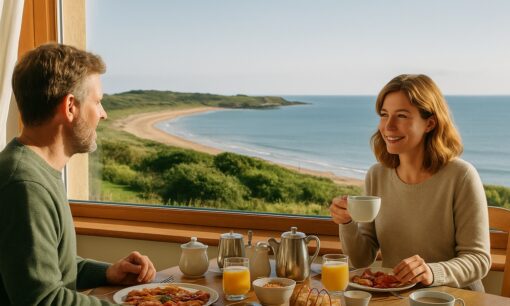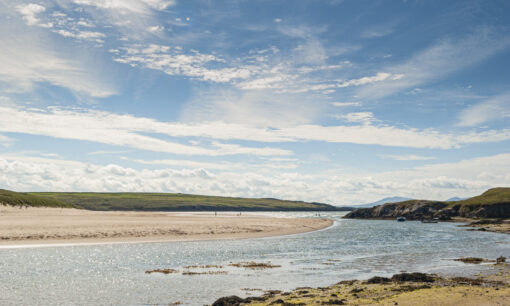Discover the Best Eco-Friendly Things to Do in Anglesey
Nine Sustainable Activities in Ynys Mon

Featured • June 06, 2024 • Author, Sharon Watkins
Are you ready to discover the Isle of Anglesey excitingly and uniquely? This article gives nine of the best eco-friendly things to do in Anglesey and the top sustainable experiences for all travellers so you can have a great trip whilst minimising your environmental impact.
Nine Eco-Friendly Activities
1. Explore the Coastal Path
One of the best ways to experience the natural beauty of Anglesey is by walking the Anglesey Coastal Path. This 130-mile trail circles the island, offering stunning coastline views, cliffs, beaches, and wildlife. The path is divided into 12 sections, making it accessible for walkers of all abilities. By walking, you significantly reduce your carbon footprint compared to other forms of transportation. Plus, it’s a great way to immerse yourself in the local environment.
Tips for Sustainable Walking
- Stick to the Path: Always stay on marked trails to protect local flora and fauna.
- Leave No Trace: Carry out all litter and avoid picking plants or disturbing wildlife.
- Use Public Transport: Utilise Anglesey’s bus services to reach different sections of the path.
2. Wildlife Watching
Anglesey is a haven for wildlife enthusiasts. The island is home to diverse species of birds, marine life, and mammals. South Stack Cliffs RSPB Reserve is a prime spot for birdwatching, where you can see puffins, razorbills, and choughs, especially during the breeding season. Another great location is Penmon Point, where you might spot seals and dolphins.
Responsible Wildlife Watching
- Maintain Distance: Observe animals from a safe and respectful distance.
- Use Binoculars: This allows you to watch wildlife without disturbing them.
- Support Conservation: Consider donating to local conservation projects or joining guided tours that support wildlife preservation.
3. Kayaking and Paddleboarding
For those who enjoy water-based activities, kayaking and paddleboarding are fantastic options. These low-impact activities allow you to explore Anglesey’s beautiful coastline and marine environments without causing harm. Porth Dafarch and Rhosneigr are popular spots for kayaking and paddleboarding, offering calm waters and scenic views.
Eco-Friendly Paddling
- Use Eco-Friendly Gear: Choose equipment made from sustainable materials.
- Avoid Fragile Ecosystems: Steer clear of sensitive areas like coral reefs and nesting sites.
- Participate in Clean-Ups: Join local efforts to keep waterways free of litter.
You can rent equipment or have lessons from several shops on the island including Funsport and Gecko Surf.
4. Discover the Island on Two Wheels
Cycling is another excellent way to explore Anglesey sustainably. The island has numerous cycling routes and bike tours that cater to different skill levels. For instance, the Lon Las Cefni cycle route, takes you through the heart of Anglesey, passing through picturesque villages and scenic landscapes. Cycling reduces your carbon footprint and allows you to experience the island at a leisurely pace.
Sustainable Cycling Practices
- Rent a Bike: If you don’t have your own, rent from local shops that promote eco-friendly practices. You can hire an electric bike from Elec Bike Hire or a regular bicycle from Anglesey Bikes.
- Respect Local Traffic Laws: Ensure your safety and the safety of others by following traffic rules.
- Stay on Designated Routes: Protect natural habitats by sticking to established cycling paths.
5. Visit Historical and Cultural Sites
Anglesey boasts a rich history and vibrant culture. Visiting historical sites like Beaumaris Castle, a UNESCO World Heritage site, and the ancient burial chambers of Bryn Celli Ddu provide insight into the island’s past. Many of these sites are maintained with sustainability in mind, ensuring their preservation for future generations.
Tips for Eco-Friendly Visits
- Use Public Transport or Bike: Reduce emissions by opting for green transportation.
- Support Local: Purchase souvenirs from local artisans and shop at markets that sell local produce.
- Follow Site Guidelines: Respect the rules and regulations of each site to help with conservation efforts.
6. Shop Low Waste Products on the Island
Anglesey offers numerous opportunities to shop for low-waste products, ensuring your visit supports sustainability. Local shops and markets provide eco-friendly options, from reusable containers to locally-made, plastic-free goods. For a comprehensive guide to low-waste shopping on the island, including recommendations for eco-conscious stores and sustainable practices, visit The Low Waste Weekly’s sustainability tour of Anglesey.
7. Wander Around The Best Anglesey Gardens
Exploring Anglesey’s beautiful gardens is a delightful way to connect with nature and enjoy the island’s lush landscapes. The gardens at Plas Cadnant Hidden Gardens offer a serene escape with their beautifully restored historic grounds, while the impressive Bodnant Garden showcases a variety of plants from around the world. For a unique experience, visit the Plas Newydd House & Garden, where you can wander through stunning seasonal displays and appreciate the island’s horticultural heritage. These gardens not only provide a peaceful retreat but also emphasise sustainable gardening practices, making them perfect for eco-conscious visitors.
8. Visit Eco-Friendly Sites
GreenWood Family Park – An Eco-Friendly Adventure
One of the top family attractions in North Wales, just minutes from Anglesey on the mainland, GreenWood Forest Park stands out for its eco-friendly initiatives. It features the world’s only people-powered roller coaster and the UK’s first solar-powered ride, the Solar Splash. The park also offers active adventure play areas, mazes, archery, jungle boats, live shows, crafts, and an indoor Enchanted WoodBarn for rainy days. It’s an incredible day out for all the family.
Anglesey Sea Zoo – Won Ethical Business of the Year in 2019
Anglesey Sea Zoo showcases over 100 species of fish and marine life from Britain’s coast. The zoo prioritises sustainability and conservation, with exhibits on local marine habitats and species protection. It was the UK’s first solar-powered aquarium, recycling or composting 95% of its waste. The zoo runs captive breeding, release, conservation, and education programs, using water pumped directly from the Menai Strait to create a natural environment. Visitors can use water refill stations on-site. Additionally, the zoo leads tree-planting initiatives and regular beach clean-ups along the Menai Strait.






